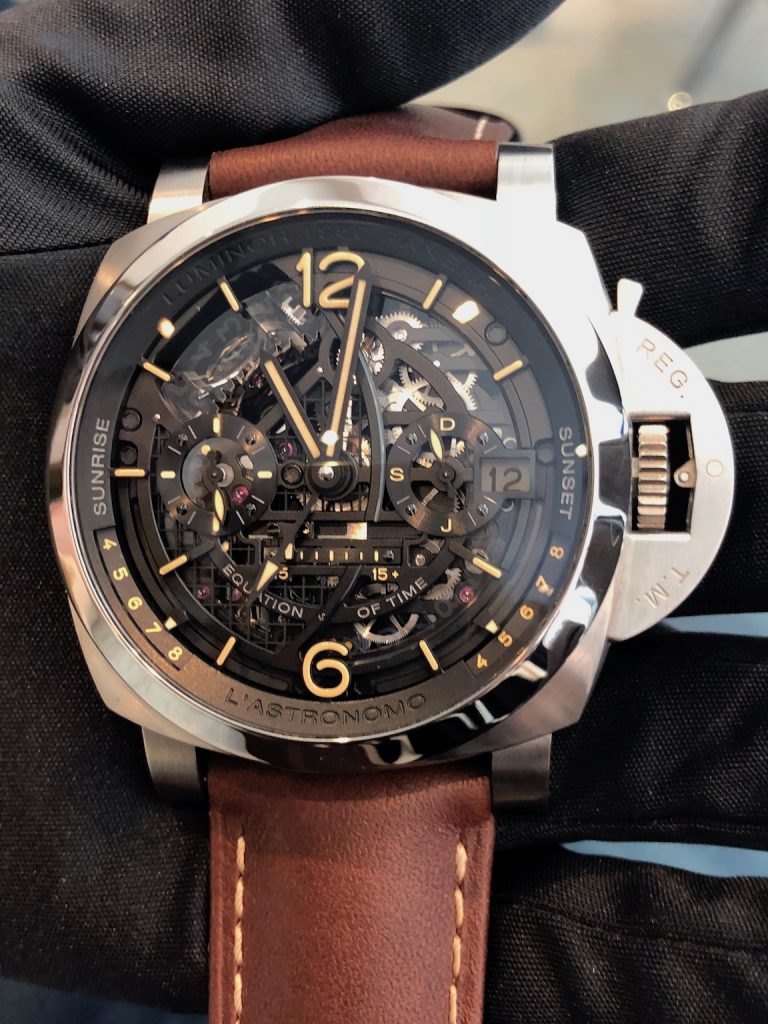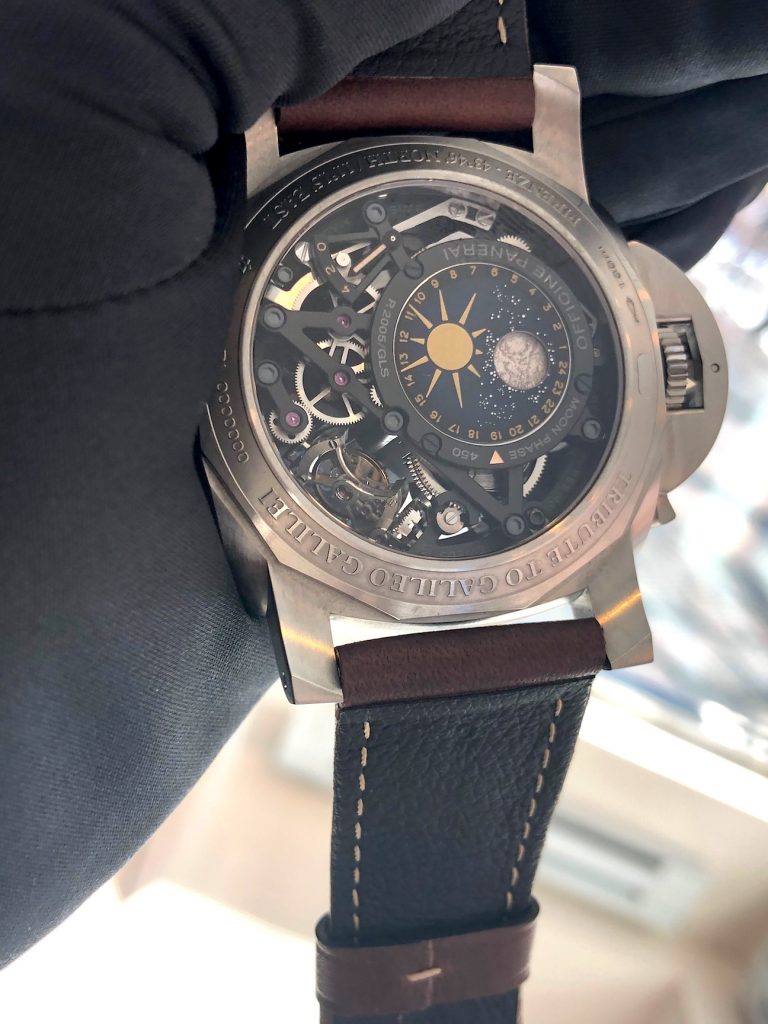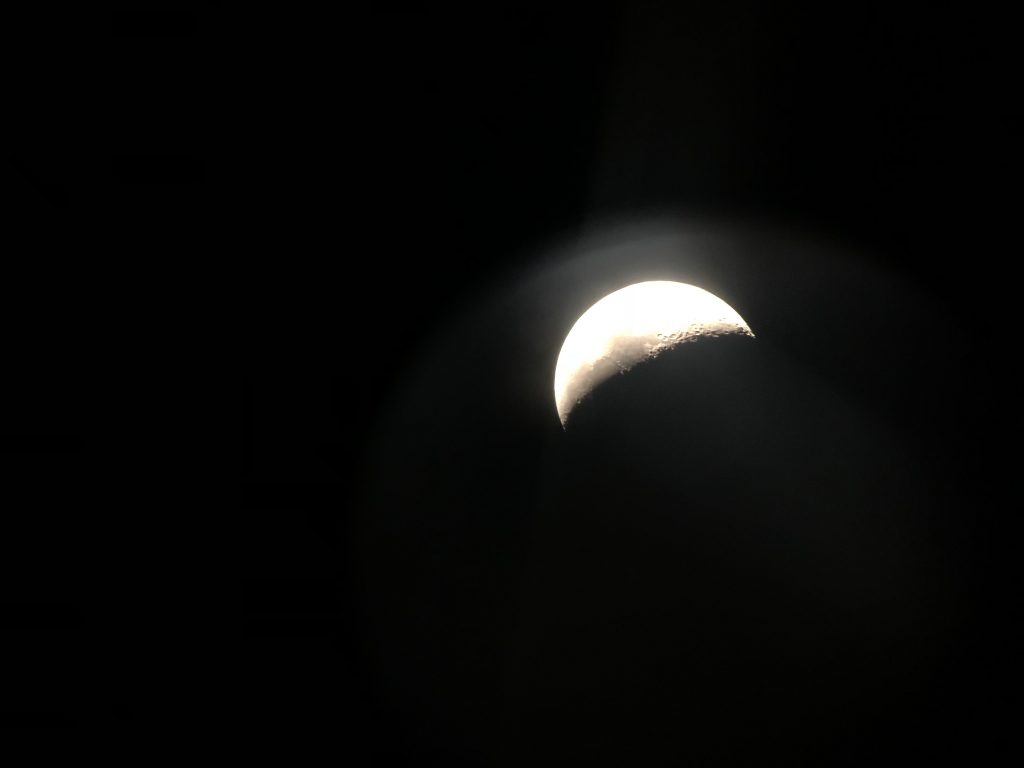
Panerai L’Astronomo Luminor 1950 Tourbillon Moon Phase Equation of Time GMT, Panerai L’Astronomo (Photo: R. Naas)
Earlier this year at the SIHH 2018 in Geneva, Panerai unveiled its newest masterpiece: L’Astronomo. Also referred to as L’Astronomo Luminor 1950 Tourbillon Moon Phase Equation of Time GMT, the 50 mm watch is the brand’s very first creation to have a moonphase indication as well as a highly creative date indication system. Recently, a very select group of journalists here in America were invited with Panerai to Aspen to view the moon through the lens of renowned National Geographic photographer Babek Tafreshi, and to go hands on with L’Astronomo.

We explored the Panerai L’Astronomo Luminor 1950 Tourbillon Moon Phase Equation of Time GMT, Panerai L’Astronomo, in Aspen with National Geographic Photographer Babek Tafreshi
The L’Astronomo Luminor 1950 Tourbillon Moon Phase Equation of Time GMT watch is crafted in titanium and houses the highly complex skeletonized hand-wound mechanical P. 2005/GLS caliber with 96 hours of power reserve. The watch offers hours, minutes, small seconds, date, month indicator, GMT, power reserve Indicator on the back, equation of time, sunrise/sunset times, moon phases indicator on the back, tourbillon. In other words, there is a lot packed into this titanium case, and a lot going on both on the dial and the case back.
Part of a series dedicated to Galileo Galilei, the watch has a few other intriguing aspects, including a unique patent-pending system for the date indication that uses polarized crystals, and is personalized to operate in accordance with the geographical coordinates of a place chosen by the client. The watch is only made to order. The case back features the day/night indication and the phases of the moon using two superimposed rotating disks. Essentially for the date indication, “the date disc is made of borosilicate glass and the numbers of the days have laser-modified optical properties. The numbers are virtually invisible in all positions except for the one that is aligned with the little date window, where a further polarized crystal, situated above the date disc, causes the number to appear so that it is perfectly legible.
The upper disc – which is read by a small external index fixed onto the movement – displays the 24 hours of the day, showing the sun during the hours of daylight and the stars of the sky at night. At the center of the starry sky is a round window through which the lower disk can be seen; on this appears the moon, its shape evolving day by day as a result of a small supplementary rotation of this disc of about 6.1° per day, a figure based on the exact duration of one lunar cycle (an average of 29 days, 12 hours, 44 minutes and 3 seconds). Given that each watch movement is made according to the coordinates of a place chosen by the watch’s owner, the indication of the moon phases always relates to the sky above that place, and of course it also takes account of the difference between the earth’s northern and southern hemispheres. Like the moon phase indicator, the indicators of sunrise and sunset times are connected to home time and therefore, if the owner of the watch should find himself in a city with a different time zone from that of the chosen city, these indicators will continue to show the situation at the time at home, which is indicated by the GMT hand.”
The equation of time, which displays the difference between actual time (solar time) and conventional time on each day, is located at 6:00 on the dial.The Panerai tourbillon escapement is also patented. It differs from a classic tourbillon in that the cage of the balance rotates continuously on itself. The mesmerizing tourbillon at 11:00 on the watch dial offers a beautfilly orchestrated constant rotation.
Wearing this watch is like going on a journey. Each time you study it, you discover something new. There are so many intricacies and so much function built into the watch that one marvels at the time and technology it took to create the piece. While it is water resistant to 100 meters, I personally would not get this beauty wet. Especially since I would have plunked down just about $230,000 for it.











